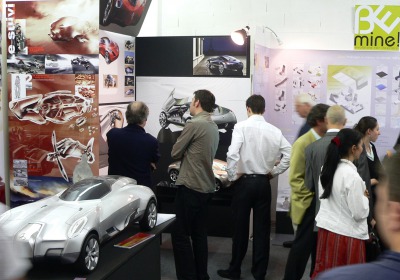College Exhibition: Strate College Degree Show 2006
Fri, 04 Aug 2006Graduating Transportation Design students at France's Strate College displayed their Diploma projects in the school's annual degree show, held at the central Paris school June 23-24. A jury of design managers from major European and international manufacturers including Renault, Citroen, General Motors, Hyundai, DaimlerChrysler and Volkswagen assessed the graduating students' work.
The exhibition included work from the schools programs in Transportation Design, Product Design, Luxury Design, Services Design, Graphic Design, Packaging Design and a new three-year program in Modeling. There were 15 graduates from the Transportation Design program. The degree projects included:
WATT
Michel Glenisson
WATT is first of all a race around the globe between New York and Paris through the Behring Straits. In this race, all cars would have the same chassis, the only difference is the energy used for the engine. For each run, every car loads the same energy load calculated in 'watt', whichever form of energy used. The race would actually become a live laboratory that could test different alternative energy solutions, using car competition, a fantastic source of innovation to promote changes in transportation to deal with dwindling oil resources. In his concept, Michel has imagined the vehicle as well as the race surroundings: logistics and media.
No Car
Gregory Blanchet
Gregory takes his inspiration in Japanese traditions, and in particular the 'No' theatre. Just like the 'No' mask, this assymetric vehicle can show the different facets of the driver, offering a natural balance in the 'unbalance' and harmony loyal to traditional Japanese culture. In the 'No' car, the interior of the mask becomes the interface between the actor and his character. Following this metaphor, the interior is designed as a true interface with a driver that can operate all personalization settings. The vehicle body also offers a screen where one can see different graphic displays that show driver's personality.
Carat
Alexey Kezha
The Carat concepts takes into consideration all the constraints a car needs to adapt itself in its environment, respecting today's trends but offering an innovative concept. Alexey proposed an asymmetrical interior that shows structure both in the interior and exterior. This asymmetrical interior gives a different percieved length to the vehicle depending on the side one looks at it. Asymmetry is also illustrated in the door openings. Inspiration is taken from luxury products when designing elements such as lights, similar to jewels.
Erko
Nicolas Rousselet
In his concept, Nicolas proposes both the vehicle and an adapted network. In this network, one no longer sees the difference between pedestrian and vehicle zones in the city. Only the sensors, designed to guide the vehicle can differentiate the different areas. This new green network brings a new harmony in cities. If roads integrate green spaces, vehicles need to respect them. The concept in based on an air cushion technology that would allow the car to float on an air cushion just above the ground when riding at its cruise speed. The car could be then maneuvered like a small plane, with control via the tail control surfaces.
By

